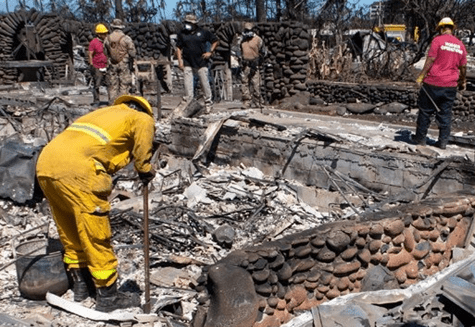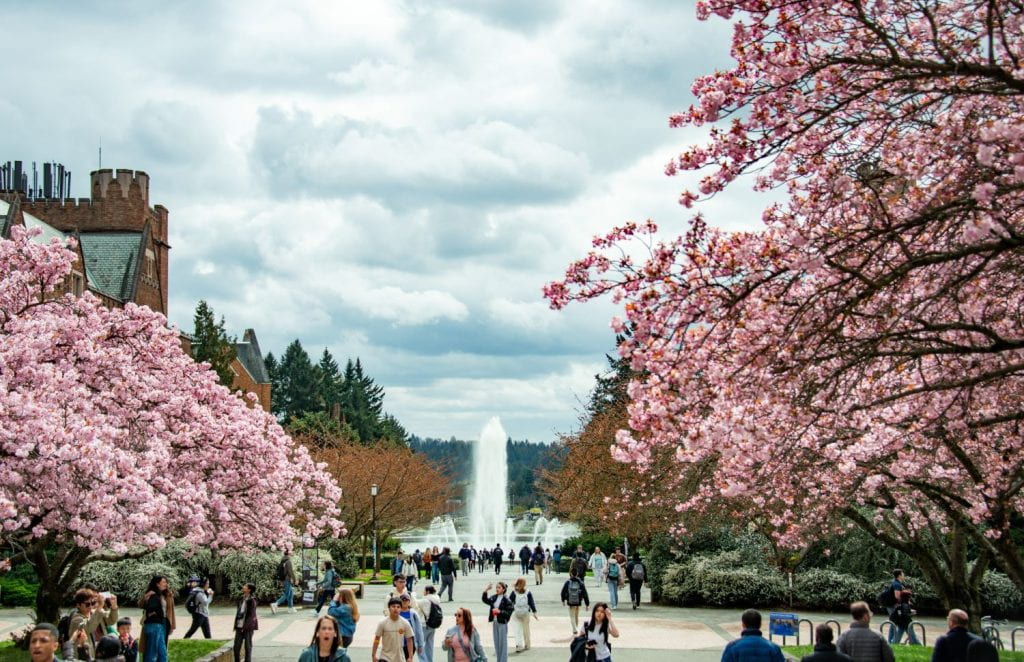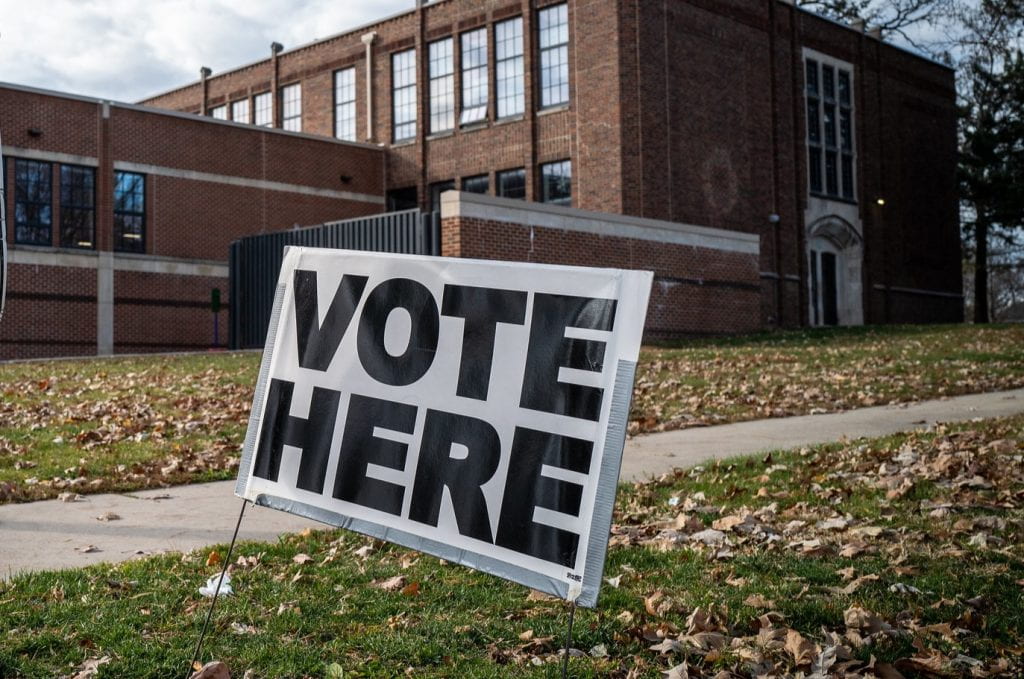RAPID RESEARCH REPORT
By Mike Caulfield and Kate Starbird
University of Washington
Center for an Informed Public
The wildfires in Lahaina were still raging as the first questions about whether they might have been “deliberately set” emerged online. Though all current evidence points to an accidental start, potentially exacerbated by negligence, much discourse online suggested something far more sinister: that the creation of large-scale wildfires on the island of Maui was part of a secret plan. The reasons suggested for this plan varied, from the purported desire of the federal government to “fake” climate change impacts, to the claim that particular elites desired to burn long-standing landholders off of their property to expand their land holdings.
On the platform formerly known as Twitter (now X), where much of the discourse centered on the idea that the government had used a “direct energy weapon” to start the fire, discourse participants engaged in conspiracy theory construction, poring over videos, photos, maps, and planning documents, constructing a grand, interconnected argument from dozens of pieces of “evidence.” The discourse was prominent enough that for a time X’s top autocomplete suggestion for “maui fires” was “maui fires deliberate.”
With conversation on X, as measured by the search results, overrun by such theories we became interested in what discourse on other platforms looked like. In this Center for an Informed Public rapid research report, we look at YouTube content discussing the fire’s causes through two methods. First, using a search term set expanded by ChatGPT, we identified videos related to the cause of the fires through scanning search results on X for YouTube links. Second, we use that same set of terms to search directly through the YouTube interface. The data collection for this report was executed between August 22 and August 23, 2023, providing a view of the information environment roughly two weeks after the fires.
We find two very different information environments based on which path (YouTube video search or X-based discovery) is followed. We discover through our X-based investigation the existence of a set of highly popular YouTube videos advancing a variety of “planned crisis event” narratives. At the same time, we find that YouTube’s search interface surfaces reliable information about the wildfire’s causes, even when prompted with a search targeted at bringing up coverage of non-existent deliberate causes.
Our findings suggest that approaches to improving the information environment for searchers on YouTube have been at least partially effective, but that other factors both internal to YouTube (existing channel subscribers) and external (social sharing on other platforms) may be driving a different kind of consumption.
Developing the Search Query
Though some events are ambiguous enough in their causes to present difficulties with identifying unfounded speculation, the Lahaina wildfire presents no such difficulties. To those who have followed the recent history of wildfires, the patterns are remarkably familiar. A mixture of weather conditions (sometimes the result of climate change, sometimes not) and poor land management creates tinderbox conditions; imperfect response or lack of preparedness multiplies the human cost. These issues are often magnified along racial or class barriers. The exact admixture of these factors in the case of Maui is still to be determined, but there is nothing to suggest the need to stray beyond the same combination of factors that have explained so many recent tragic fires. In light of these explanatory factors, any claim that the human and economic costs of the Maui fires were the result of a deliberate, coordinated plan would require substantial evidence, far beyond anything so far surfaced.
To better understand how social media content advances a counter-narrative of deliberate cause, we investigated YouTube videos surfaced through two different search methods: First, through examining YouTube videos shared on X, and second through searching the YouTube interface. To make the comparison of these two views as meaningful as possible we created a single query to use in both environments.
In order to avoid search term bias, we used ChatGPT to produce a set of terms, using the seed term “deliberate.” While ChatGPT has many flaws as an analytical tool, it is fairly effective at generating lists of things people might say. We used that to our advantage by asking ChatGPT 4 to generate a list of phrases that a person claiming a wildfire was deliberate might use, and then extracting the modifiers used. Our seed question was to “Generate a list of phrases that someone claiming a wildfire was set deliberately might use.” From the phrases returned, we extracted the initial modifiers, for instance from “intentional ignition” we selected “intentional” and from “traces of accelerants” we selected “traces.”
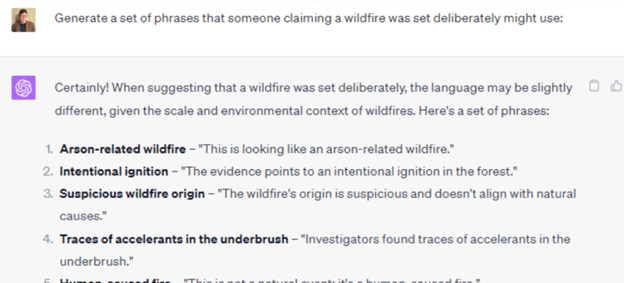
We then combined that with topical terms to produce the following term set:
(Maui OR Lahaina OR fires OR fire OR wildfires OR wildfire) (Arson-related OR Intentional OR Suspicious OR Traces OR Human-caused OR Deliberate OR Man-made OR Evidence OR Signs OR Malicious OR Strategic OR Unnatural OR Harmful OR Intentionally OR Uncharacteristic OR Targeted)
We deviated from this term set in only two ways. First, on YouTube we eliminated the “signs” term, as the phrase “fire signs” was returning many astrology videos. To deal with a similar issue on X, we used these exclusion terms:
-“fire signs” -leo -aries -sagittarius.
We did not use the exclusion approach on YouTube as using exclusion terms of any type seemed to overlimit results, possibly triggering a more general change in how search was processed.
X-Based Discovery
Both during the fires themselves and in the aftermath, X discourse has leaned into conspiracism, with much of the discourse centering around theories the fires may have been deliberate. We hypothesized that searching X for links to YouTube might provide us a list of popular videos on YouTube discussing the theory that the fires were deliberate, as well as a view of what was being shared on at least one social platform. In the process, we found that YouTube sharing on this topic on X was relatively low, but still surfaced a variety of popular videos espousing such theories.
We also wished to explore what rapid research might look like on X now that the academic API has been retired. The methods used here are rudimentary and exploratory (and decidedly smaller scale than some of our earlier big data explorations) but still surfaced useful insights into the online information environment as a whole.
X’s media tab dominated by native content, much of it engaged in conspiracism
Our initial attempt to discover YouTube videos was to put our search query root in the media tab of X, which surfaces a selection of tweets with both native and external media assets. After logging 315 items from the tab, we ranked them by views.
The following represent the top 10 posts found through the media tab that marched our search terms. The views are the views of the post, not the included video.
| Views | Date | Text |
| 2.3M | Aug 14 | Hawaii Senator Brian Schatz can’t even hide his smirk as Maui burned. He’s seeing dollar signs for huge Democrat donors (Oprah, Zuckerberg, other billionaires) who will scoop up the land and steal it from native born Hawaiians. [Twitter Video] |
| 1.8M | Aug 14 | As you can see from this CA video, Directed Energy Weapons (DEWs) somehow only burn houses, buildings, and cars but not trees. This is what happened in Maui. This was a targeted attack against innocent Hawaiians. [Twitter Video] |
| 1M | Aug 11 | ISLAND TAKEOVER Credible Source Tells CBKNEWS The Lahaina Fire Was Intentionally Set To Depopulate Maui And Pave The Way For A Buyout Of All Property Owners ‘Ellison already owns the nearby island of Lanai. Oprah amassed 2,000 acres and Bezos has his eyes on it too.”… Show more [Twitter image] |
| 842.6K | Aug 12 | Lahaina Hawaii…Even the most Indoctrinated, Boot Licking, Compliant of Sheep would agree that these fires look slightly suspicious at least. Not one scorch mark on ANY of the roads. Decide for yourself [Twitter Video] |
| 259.5K | Aug 16 | Unbelievable statement by a #Lahaina resident : “The police kept people inside a perimeter and were blocking them from leaving #Lahaina while the fires were spreading” Do people now understand why ‘conspiracy theorists’ thought it was suspicious that this former, Las… Show more [Twitter Video] |
| 242.1K | Aug 13 | Don’t be suspicious, don’t be suspicious! #Lahaina #LahainaFire #LahainaFires #Maui #MauiFire #MauiFires #Hawaii #HawaiiFire #HawaiiFires #DEW #TheGreatReset #15MinuteCities #agenda21 #WarOnHumanity [Twitter Video] |
| 171.4K | Aug 15 | Maui wildfires spark conspiracy theories about space-lasers, Oprah land grabs, and suspicious trees https://trib.al/kT3Sl6G
[link to NYPost article debunking conspiracy theories] |
| 118.6K | Aug 10 | Can’t get over how structures are completely incinerated but there’s green trees nearby untouched END TIME – The fire damage in Hawaii leaves open the question of whether the fire was caused by a deliberate nature. In other words; was the cause a energy weapon? [Twitter Video (Gallery of 3)] |
| 108.6K | Aug 14 | nor sure if this is real but … Evidence of Directed Energy Weapons in the Lāhainā fire (40 seconds) Watch for the pulse flashes. [Twitter Video] |
| 105.1K | Aug 16 | Notice the houses are on fire but not the trees…how did fire spread house to house? That’s a little suspicious, don’t you think? [Twitter Video] |
The query did well in surfacing popular X video content presented as “evidence” of a grand, deliberate fire-setting plan, with over half the videos engaging in some form of discourse conspiracism, and three raising a “Direct Energy Weapon” conspiracy theory outright. However, almost all of the video content logged in the media tab was native content, not external video, and few YouTube links were found.
Given the small number of YouTube links found in the media tab, we expanded our link collection strategy. Appending “youtube” to our terms, we chose the “latest” tab, scrolling back until we reached August 8, 2023. The 88 items scanned produced 45 unique YouTube links. Eliminating items which did not have to do with fires, climate change, or related conspiracy theories produced a set of just 35 unique YouTube video links. Together with two unique links from the first set the total of the two collection methods was just 37 links.
X-based discovery surfaced popular videos advancing the “deliberate” theory
While the links shared on X were not viral on X they were, on average, linked to quite popular videos on YouTube, validating our discovery approach. Of the top 10 links the average YouTube view count of X-discovered video was 433,000 views. (The average YouTube view count of the top 10 YouTube surfaced links, described later in this report, was 607,000 views).
Top X-discovered videos by YouTube views
| YouTube Views | Account Name | Video Title |
| 940000 | Two Bit da Vinci | The Maui Fires – REAL Reason They Happened |
| 928000 | KENS 5: Your San Antonio News Source | Death toll in Maui reaches 93 lives lost and still climbing |
| 722000 | [ANONYMIZED] | Locals Tell What REALLY Happened Maui Fire |
| 435000 | DW News | Anger in Hawaii over government response to fires, as death toll rises |
| 409000 | [ANONYMIZED] | BREAKING NEWS: Oprah Winfrey INVESTIGATED for Maui Fires! |
| 239000 | Dr. Steve Turley | The TRUTH about the Maui Fires EXPOSED? |
| 232000 | Anonymous Official | A Message to Maui… The Truth May Shock You |
| 146000 | CBS News | Warning signs seen for hours before Hawaii wildfires, children and elderly among the missing |
| 146000 | [ANONYMIZED] | What the Media Won’t Tell You: Maui Fires |
| 141000 | Guardian News | Hawaii: Maui residents escape wildfires while strong winds cause blaze to spread |
| 123000 | Sky News Australia | ‘Anti-white racism’: Farmers being targeted in South Africa |
| 89000 | [ANONYMIZED] | The puzzling fire of Maui |
| 72000 | [ANONYMIZED] | New Footage From Maui (THIS IS NOT NORMAL) ⚠️ |
| 72000 | WFAA | Severe weather in eastern U.S. impacting flights |
| 69000 | [ANONYMIZED] | LOOKING FOR CLUES in the CANADIAN FIRES |
| 62000 | [ANONYMIZED] | Maui Fire Update August 14 2023 |
| 41000 | [ANONYMIZED] | [death toll rising] MAUI CAUSE OF FIRE SUSPICIOUS [hawaii digital government summit] |
| 39000 | [ANONYMIZED] | Maui Fires started on PURPOSE?! Conspiracy Theory PSYCHIC READING |
| 35000 | GBNews | Climate crisis fearmongering? |
| 31000 | [ANONYMIZED] | Were The MAUI Fires INTENTIONAL? 👀 |
There are a couple of surprises in this list. Despite its title, the top X-discovered video here (The Maui Fires – REAL Reason They Happened, by Two Bit da Vinci) is not a conspiracy theory video, but rather an informed deep dive into all aspects of the Maui fires. It is possibly the most comprehensive treatment of the event out of all the videos we analyzed, discussing everything from climate change to invasive grass, and it ends with a debunking of common wildfire conspiracy theories, while validating concerns about predatory behavior by investors and acknowledging a history which has led to distrust and tension. One interesting aspect of this video is how it uses a discourse style associated with conspiracism (a headline about the “real” reason, an aesthetic of amateur discovery, etc) to gain the views of people who might otherwise be attracted to more manipulative videos, and it raises the question of whether such media might be a useful format for some debunking videos to emulate.
A number of other videos in this list are from reputable news sources. However, over half the videos in this list are less useful to those looking for answers to the cause of the fire, and range from a “just asking questions” posture to outright advancement of conspiracy theories. The “evidence” presented of an “unnatural” origin in many of these videos echoes that presented in native videos on X. Some examples from the videos:
| Purported Evidence | Reality |
| Level of destruction not possible by fire alone | Wildfires create temperatures of over 1400 Fahrenheit, enough to cremate a body, or melt aluminum rims. |
| Pattern of destruction is not typical of wildfires | In fact, patterns of burning seen in Lahaina are quite common and easily explained. |
| Previous fires either “don’t match this fire’s patterns” (proving fire is suspicious) or “do match” (proving a broad, ongoing conspiracy) | This one is what scholars of conspiracy theory call self-sealing, but for the record the Lahaina wildfire looks very much like past wildfires. |
| Elites (such as Oprah) or the government had ulterior motives for burning residents out, and therefore are likely to have done so | While there has been some predatory behavior from outside developers after the fire, the case against named elites such as Oprah seems to be that they bought land on Maui before the fire – which is no evidence at all. The case against the government involves even more fantastical claims, debunked here. |
| Disaster response was flawed and therefore a sign of an intent to maximize damage | Evidence cited here is a mix of many false claims as well as some true claims that might imply an imperfect response, but do not suggest intent. This fact-check runs down some of the major misrepresentations about the response. |
In many cases those narrating the videos present themselves as “covering” conspiracy theories of others, but do not provide easily available information that could debunk the theories they raise or show the evidence they mention to be misrepresented or fabricated. In some senses this is a parallel to the well known conspiracy theory tactic of “just asking questions,” as they are “just covering conspiracy theories.”
YouTube Platform Search
After verifying our query string worked as intended we executed a relevance search on YouTube, which returned 40 results. After pulling the data into a spreadsheet we produced two rankings of those 40 items, the top 10 videos as initially returned and the top 10 of those videos by views. The two tables are shown below. The “S” column indicates whether the video was a “YouTube Short,” a newer format discussed.
Top 10 search results as returned
| Rank | Views | Source | S | Title |
| 1 | 35K | ABC 7 Chicago | Video puts scrutiny on possible cause of Maui wildfire | |
| 2 | 45K | 11Alive | Y | Man describes ‘firebombs’ in Maui #maui #hawaii #wildfire |
| 3 | 467K | ABC News | Security video appears to show what triggered deadly Maui fire l GMA | |
| 4 | 320K | Vox | Y | The surprising factor making Maui’s wildfires worse #maui #hawaii #wildfire |
| 5 | 194K | Guardian News | Why the Maui wildfires spread so devastatingly fast | |
| 6 | 442K | ABC News | New video from Maui fire survivors | |
| 7 | 522K | CNN | Y | Woman escapes Hawaii wildfires |
| 8 | 98K | ABC7 News Bay Area | Y | Maui wildfires turn family vacation ‘apocalyptic’ |
| 9 | 83K | NBC News | What ignited Maui’s wildfires and why did they spread so fast? | |
| 10 | 250K | WKYC Channel 3 | Y | Hawaii fires: Historic Lahaina town destroyed by Maui wildfires |
Top 10 search results when returned results re-sorted by views
| Rank | Views | Source | S | Title |
| 1 | 1.7M | PBS NewsHour | What fueled the Hawaiian wildfires that killed dozens and leveled historic Lahaina town | |
| 2 | 580K | CNN | Video shows Hawaii wildfires spreading across Maui | |
| 3 | 542K | Reuters | What caused the devastating Maui fires? | |
| 4 | 522K | CNN | Y | Woman escapes Hawaii wildfires |
| 5 | 486K | ABC News | Y | New video shows a massive fire raging near homes in Maui, Hawaii |
| 6 | 477K | 11Alive | Hawaii fires before/after aerial photos of Lahaina, Maui | |
| 7 | 467K | ABC News | Security video appears to show what triggered deadly Maui fire l GMA | |
| 8 | 442K | ABC News | New video from Maui fire survivors | |
| 9 | 435K | DW News | Anger in Hawaii over government response to fires, as death toll rises / DW News | |
| 10 | 398K | Inside Edition | Some Hawaii Wildfire Victims Jump Into Ocean to Escape Flames |
Overall, even with a search query looking for evidence of deliberate setting of the fires, the results from YouTube’s search returned were informative and authoritative, bringing reputable news coverage to the top of the results. The results show that some reputable “deep-dive” videos have done quite well. The top-viewed video in this set, for example, is an 8-minute video from PBS NewsHour that features an extended conversation with a local Maui meteorologist who names the immediate cause as likely being a downed power line. The top ranked video on relevance reveals a similarly likely cause, with ABC 7 Chicago airing an Associated Press-produced story that interviews a man who filmed a downed power line that caused a grass fire shortly before the wildfire started.
Both searches also returned some items in YouTube’s newer “Shorts” format, a TikTok-like vertical format launched in 2020. On the whole the Shorts format, which is limited to 60-second videos, provided helpful information. The format here is most often used as a way to show resident-captured footage without additional comment, such as the footage one woman captured from her car driving past the fires. One short used the video format for explanation: the Vox “explainer” video provides a 40-second explanation of why non-native grasses that have become invasive in Maui may be partially to blame for the intensity of fires, as they are not well-adapted to the local climate.
Out of both of our top 10 lists the only video that did play into the “fire was of unnatural origin” trope was also the top-rated Short in our relevance ranking, a 13-second clip with 45,000 views. In it a witness, likely describing the elsewhere-reported explosion of cars during the fire, describes “fire bombs” that were “exploding everywhere.” Outside the conspiracy theory frames that dominate the Lahaina fires conversation such a description would be uncontroversial. With these frames active, however, it is likely that a lot of the sharing of the decontextualized clip is to support the conspiracy theory that the fires were a result of a Direct Energy Weapon. The top comments, with many likes, support the view that this is how the video is being used and interpreted.
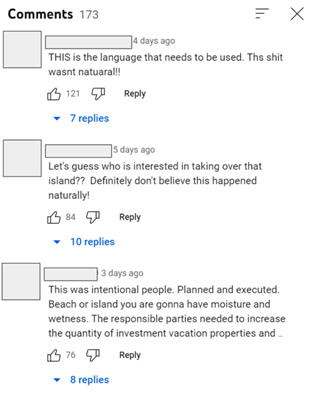
The video appears to be a video snipped by a news organization from a longer video of theirs, in a feature YouTube calls clipping, and was likely not intended to support any conspiracy theory. But given the comments, it stands as a reminder to news organizations that short content of this sort can be easily miscontextualized.
Conclusion and Recommendations
While our research was far from comprehensive, it sheds light on a number of interesting trends, which we detail here.
Search was an effective information-seeking strategy on YouTube in the wake of the crisis event.
First, and perhaps most importantly, our findings demonstrate that during a specific crisis event individuals who turned to YouTube search with legitimate questions about the cause of the wildfire were likely to receive reliable information about causes, even when their search terms leaned into a “conspiracism bias.” Given past research about some of the failings of YouTube search and recommendations, the strong performance of the search engine during an unfolding event was a welcome surprise, and adds to recent research showing that YouTube’s algorithms do not currently seem to be a driver of new viewers to extremist or alternative media content. Consistent with that research, external links, subscriptions, and personal recommendations based on those subscriptions are more likely drivers. While we found popular native content of this sort on Twitter, we did not find any evidence that Twitter is a substantial external source of YouTube views — though that may reflect limitations of our methodology in Twitter’s post-Academic API era.
This finding has ramifications for advice given to the general public on how to find information during crisis events. A growing body of research supports encouraging web readers to “zoom out” and search for information using search engines rather than simply viewing the video or article they first encounter on their social media feeds. Critics of that approach have often countered that search itself can be unreliable, or that users using biased search terms might find themselves drawn deeper into conspiracy theories. However, our findings here demonstrate that in this circumstance an individual counseled to “zoom out” and search YouTube would find helpful information — even when their search terms reflect a “conspiracy bias.”
As the popular conspiracy theory videos we found on X were also found through search, our findings also serve as a reminder that specificity in the teaching of lateral reading remains necessary. It is not enough to simply tell the general public to open up another tab and search — instruction is needed on the relative strengths and weaknesses of various search platforms. While such a finding is not news to those engaged in lateral reading interventions, the importance of specificity has sometimes been missed as lateral reading advice has been translated for the public.
Molloy’s Law remains in effect. And news organizations should be aware of it.
The blogger Parker Molloy has on a number of occasions detailed important advice for dealing with video online: “the tighter a video is clipped, the less inclined you should be to share it.” In our current investigation we found one area where this advice held in particular — a 13-second “Short” likely meant to capture a compelling witness account, but broadly perceived and shared as confirmation of several fringe conspiracy theories.
The general public should be aware that Shorts — even ones from reputable news sources — are easily miscontextualized. When confronted with short video, the public should apply a lateral reading methodology such as SIFT. First, ask whether you “know what you’re looking at” — in the case of a 13-second video the answer is usually that you don’t. Then seek additional context, either by searching for more information about the event, or by finding the longer, original video. For example, in this case searching for “Lahaina” and “exploding” with Google returns a video where another witness describes the “gas stations exploding” and many more articles describing the explosions of propane tanks, or in some cases burning cars — far different causes than many commenters on the video were suggesting.
At the same time, news organizations should be aware that such clips have a higher potential for misframing. When producing a short clip — whether for circulation on YouTube, Instagram, or TikTok — producers should have and apply an awareness of active conspiracy theory frames through which people may view such clips, and where possible clarify through the addition of context in overlays or through expanding the length.
New debunking formats worth exploring
While this final insight is more speculative, we were intrigued by the overwhelming popularity of the “Two-Bit DaVinci” video, which emulated in its title and in some of its aesthetic elements conspiracy theory discourse, while still providing good information.
The success of the video raises interesting questions. Many debunking efforts rightly target the general public, with dry headlines, concise treatments of the issues, and favor consulted expertise over amateur investigation. While this is an ideal format for many readers and viewers, it’s possible that some viewers would be better served by videos that lean into conspiracism-adjacent norms. Such norms might recognize that many search explicitly for videos claiming to reveal the “real” story, and that a certain portion of the public would rather see a talented amateur walk through an investigation step-by-step than receive a summary of expert opinion. The “Two-Bit DaVinci” video also contradicts another broadly accepted norm of public crisis communication — far from being short and concise, it is a 30-minute video, filled with an immense amount of detail.
Would such videos be more effective for a conspiracism-prone subpopulation that distrusts experts, rejects the value of summary, and values being included in the discovery process? It’s not possible to know from this investigation, but the striking success of a video that violates many accepted norms of crisis communication argues for taking a deeper look at this format.
Mike Caulfield is a research scientist at the University of Washington’s Center for an Informed Public. Kate Starbird, a UW Human Centered Design and Engineering associate professor, is the CIP’s director and a CIP co-founder.
Photo at top: Maui Fire Department personnel and other first responders conduct search and recovery operations in Lahaina. (Photo courtesy Maui Fire Department via Facebook)

